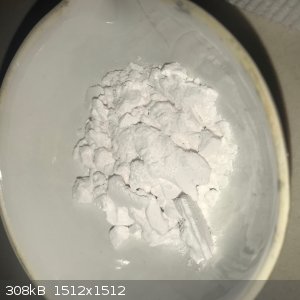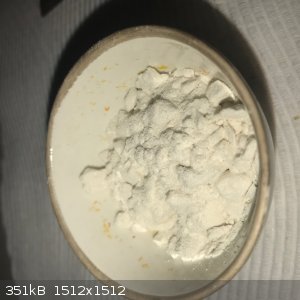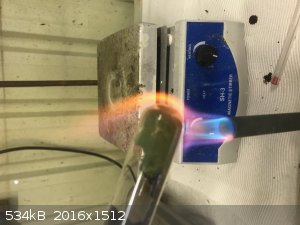Lion850
National Hazard
   
Posts: 514
Registered: 7-10-2019
Location: Australia
Member Is Offline
Mood: Great
|
|
Report on making manganese oxalate and attempt to isolate green MnO
The reason for making manganese oxalate was to try and then make the green manganese ii oxide MnO.
The first method was by simple double displacement reaction:
- 20g MnSO4 (fertilizer grade) dissolved in 50ml water by stirring and heating. This have a very pale pink solution.
- 24.5g potassium oxalate monohydrate in 50ml water, stir and heat. This gave a clear solution.
- Add the potassium oxalate solution to the manganese sulphate solution while stirring. The solution became milky with suspended particles.
- Add 5ml glacial acetic acid (I read somewhere that this reduces the solubility of manganese oxalate in excess potassium oxalate) and stir 20
minutes.
- Stop stirring. The white ppt quickly settles.
- Decant supernatant liquid. Add 200ml water, stir 10 minutes. Let settle and decant the supernatant solution. Repeat this twice.
- Pour into funnel and rinse with water.
- Left on bench on filter paper and paper towel for 2 days to dry.
- This gave 20.5g of a soft fluffy white powder. This is 2 grams or so more than the expected maximum, so it was either a hydrate or not fully dry.
Photo below.

Second method was based on the below that I read in a Russian patent:
"A known method of producing oxalate, manganese (II) (Vasiliev SG, A.A. Granovsky, Tairova A.A. Laboratory work in General and inorganic chemistry.
L., Chemistry, 1986, s), based on the stoichiometric equation
7H2C2O4+2KMnO4+2CH3COOH→2MnC2O4+2KOCOCH3+10CO2+8H2O
According to him it is heated to boiling saturated solution of oxalic acid, acidified with acetic acid and slowly poured with stirring to a hot
solution of potassium permanganate until slightly pink color, then give the resulting solution was left standing. After coagulation of the
precipitate, the liquid is poured, the precipitate washed twice by decantation, filtered, washed with water and dried in a Cabinet at 150°C to remove
water of crystallization."
- 63g oxalic acid was dissolved by heating and stirring in 400ml water. It gave a clear solution. Based on the MSDS this should be anhydrous oxalic
acid but I have my doubts.
- 12.8g glacial acetic acid was added to the oxalic acid solution - no obvious reaction.
- 31g potassium permanganate dissolved in 100ml of warm water - this was surprisingly difficult to dissolve; in fact some did not dissolve.
- Slowly add the potassium permanganate solution in small portions to the oxalic acid. Each addition produces a vigorous reaction. Gas bubbled out,
the permangate turned brown and then disappeared.
- It reached a point where the color of the solution remained brown. It did not clear. Adding then a few grams of oxalic acid cleared it up. This was
unexpected at the time as there was still quite a bit of potassium permanganate left. Maybe my oxalic acid is the more common hydrate?
- I got to the point where a tiny bit of permanganate would keep it light brown, and a fraction of a gram of oxalic acid would clear it. At this stage
there was also a lot of suspension swirling around. I decided this was closed to the neutral point and stopped adding more permanganate solution.
- The white ppt settled quick, and was washed with 2 x 500ml portions of water by decantation, and then again in a funnel, same as method 1.
- The ppt was left to air dry for 2 days. The result was again a soft white powder, but not as pure white as the first. 24.4g was recovered. Photo
below.

A sample of each product was heated in a test tube on a bunsen burner. In both cases the olive green color of manganese ii oxide MnO appeared.

When tipped out of the test tube when still hot, it glows as it falls through the air and quickly changes to black MnO2.
I did not manage to recover any of the green oxide...that will be a future step.
|
|
|
Bezaleel
Hazard to Others
  
Posts: 444
Registered: 28-2-2009
Member Is Offline
Mood: transitional
|
|
Hi Lion850, making the green MnO is possible in only a very limited number of ways. Usually the crystal phase obtained is the unstable one and you
will see what you observed: that it turns back into the black oxide quickly.
The only way that the stable phase forms, is in an environment rich in HCl and poor in O2. Once formed in the right phase, MnO is stable. I have a MnO
sample here which I obtained as a by product, an impurity while making MnCl2 from HCl solution. The sample is at least 7 years old now and is still as
green as it was when I made it.
I never got to deliberately producing a larger amount of MnO, although it has a delicate and appealing green.
Check Compt. Rend. 53 (1861) pp 201-202.
|
|
|
Lion850
National Hazard
   
Posts: 514
Registered: 7-10-2019
Location: Australia
Member Is Offline
Mood: Great
|
|
Hi Bazaleel thanks for the comment. I cannot locate the reference you mention. Do you perhaps have a link?
|
|
|
Bezaleel
Hazard to Others
  
Posts: 444
Registered: 28-2-2009
Member Is Offline
Mood: transitional
|
|
I got it from Gallica. I find Gallica quite hard to search, but this link helps you out for Comptes Rendus.
Relevant article is attached.
Attachment: Comptes Rendus 53 (1861) pp 199-202.pdf (217kB)
This file has been downloaded 189 times
|
|
|
|